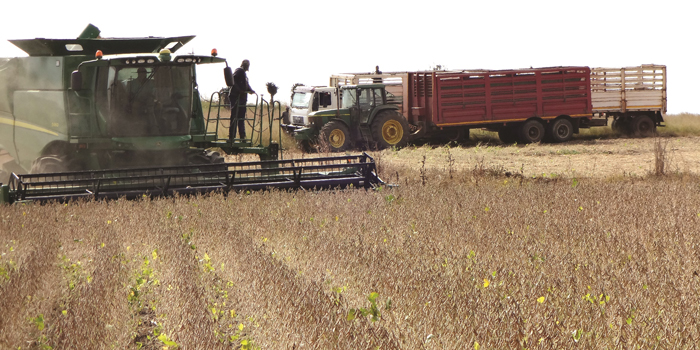April 2024
| PIETMAN BOTHA, INDEPENDENT AGRI- CULTURAL CONSULTANT |
 |
Although there will always be harvest losses, one should try to minimise it. To achieve zero losses, the combine harvester would have to move at such a slow pace that you will never finish harvesting in time. The key is to achieve a balance between a suitable work rate and limiting harvest losses to acceptable levels.
Select the best suitable cultivar for your farm to reduce sunflower and soybean harvest losses. It is important to plant a range of soybean and sunflower cultivars with different growth lengths that are adapted to the area. This will make the harvesting period longer in order to harvest all cultivars at optimal times and will also reduce crop losses.
Acceptable harvest losses for sunflower are about 3% to 5% of the crop. For soybeans it represents approximately 2% to 4% of the total potential yield under good harvest conditions.
MEASURING HARVEST LOSSES
Before looking at reducing harvest losses, you must measure and assess where the losses occur. This will allow you to calculate the losses and where the seed is lost.
Normally losses occur in four areas – pre-harvest losses, header losses, combine threshing losses and then losses with the loading and transportation of the crop. It is important to measure every area to make the necessary adjustments.
To measure the loss, it is essential to count the pips per square metre. This can be done by putting out metre-by-metre boards just after the header passed. Count the pips on top and under the boards, and then multiply it by an average pip weight to calculate the loss per hectare.
Ensure that all the sunflower heads and soybean pods are threshed clean. As a rough guide, 100 seeds per square metre (including the unthreshed seed) is equivalent to about 100 kg/ha for sunflowers. With this information specific adjustments can be made.
Pre-harvest losses
This is where seed is lost or shed before the combine harvests the crop. It can be caused by birds or mammals eating seed, plants falling over and heads not being picked up by the combine later on, or by heads rubbing against each other in the wind, causing seeds to become dislodged.
Pre-harvest losses can be reduced by being prepared to harvest the crop when it is ready and finishing in a timely manner. Waiting for seeds to become too dry increases the risk of pre-harvest losses, so it is generally better to combine at higher moisture levels. It is important that regular samples are tested to determine the moisture percentage and to start when the moisture percentage is in line with the crop regulations.
Header losses
Seed, heads and pods are lost at the combine header and are not gathered into the machine. The rate of losses depends on the skills of the combine driver, crop condition and type of header being used. Sometimes the header performance can be drastically improved, simply by reducing the forward speed and making sure the cutter bar is in proper condition. Being patient during harvest can be to your advantage.
Most header types will cope with sunflowers and soybeans if set up correctly, but investing in speciality headers can be a good investment. There are currently some well-made and competitively priced models for both sunflowers and soybeans available.
For sunflower harvesting the main objective is to gather heads with minimal stalks entering the combine and minimal seed loss from shattering. This can be achieved by raising the combine header high enough to take in the heads while reducing the number of stalks and keeping the heads intact – so it passes through the combine whole or in a few large pieces. One sunflower head contains many seeds, so making sure they all pass through the combine will help largely to reduce sunflower harvest losses.
The objective for soybeans is to gather the most pods, with minimal stalks entering the combine and minimal seed loss from shattering. This can be done by doing the following:
Combine threshing losses
Once the sunflower heads or soybean pods are gathered in the combine, the incorrect drum, concave and sieve settings can lead to excessive losses. This is because the seed is not effectively threshed out of the heads or pods, or is allowed to pass over the back and is ejected along with the trash.
For sunflower, the aim is to get a completely threshed head onto the straw walker in one piece. Although different combine harvesters will have different optimal settings for sunflowers, the general guide is to combine at a reasonable forward speed, use a slow cylinder speed, have concaves well open, use a low airspeed and harvest when seed moisture is low.
For soybeans, separating problems result from worn parts on the cylinder or rotor, and improper cylinder or rotor clearance or speed settings. The separating equipment must be in good condition to handle soybeans with green or tough stems. Adjustments made to the cylinder or rotor clearance and speed are a balancing act between separating losses, seed damage and split beans. Make one adjustment at a time and inspect the cleanliness of the grain in the tank to determine your progress towards minimising separating losses and maximising seed quality.
Sunflower seeds are light, so the fan airspeed should be low – if it is too high, it will blow seed over the sieve, and seed forced over the sieve and into the tailing’s auger will be returned to the cylinder and may be dehulled. Set the fan so that only enough airflow is created to keep trash floating across the sieve.
The airspeed is also very important for soybeans and regular inspections are needed to make sure the soybeans are not blown out or there are too many sticks in the grain bin. Set the fan so that only enough airflow is created to keep trash floating across the sieve.
Aim for a combine speed of about 5 km to 8 km per hour. If the seed’s moisture content is low, then a slower speed should be used to reduce shatter loss, while a higher speed can be used when the seed has a higher moisture content.

Try to minimise harvest losses by setting your combine harvester correctly.
TOP TIPS FOR A SUCCESSFUL SUNFLOWER AND SOY-BEAN HARVEST
Publication: April 2024
Section: Pula/Imvula